
© Eva Marie Uzcategui/AFP/Getty ImagesA manatee swims in a recovery pool in Tampa, Florida.
Environmental groups in Florida are warning that
unusually high numbers of manatee deaths in the first five months of the year, blamed in part on resurgent algal blooms contaminating and destroying food sources, could threaten the long-term future of the species.
The 749 fatalities recorded by the Florida Fish and Wildlife Conservation Commission (FWC) to 21 May surpassed 637 from the whole of 2020, the agency said. The total is on course to exceed the high of 804, set in 2018.The dying off of substantial areas of seagrass, the favoured food source for the slow-moving aquatic mammals, has caused starvation. The situation has been exacerbated by the recurrence of inland blue-green algal blooms and phytoplankton blooms in Florida waterways.
Offshore, the recent leak and discharge of toxic wastewater into Tampa Bay from the abandoned
Piney Point fertilizer plant and the return of the
red tide algal menace has poisoned waters. FWC says 12 manatee deaths so far this year were from
confirmed or suspected red tide blooms, but the real figure could be far higher because not every dead manatee is necropsied.
In the 150-mile Indian River Lagoon, an inland estuary that as many as a third of the estimated remaining 7,500 manatees visit each year, 58% of seagrass has disappeared since 2009, according to the St Johns river water management district.The agency says too much nutrient run-off, specifically nitrogen and phosphorus, is either killing the seagrass outright or forming blooms that block sunlight.
"The vast majority of the once 80,000 acres of seagrass within the Indian River Lagoon have been lost to a continuing series of harmful algal blooms, which have themselves been caused by decades of human nutrient pollution from wastewater and runoff that continues unabated to this day," Bob Graham, a former Florida governor and co-founder of
Save the Manatee, said in an editorial published by the
Tampa Bay Times.Meanwhile, the Center for Biological Diversity (CBD) expressed its concern over a
March study that showed traces of pesticides in more than 55% of manatees tested.
"Our beloved chubby sea cows are dodging boat strikes, reeling from red tide and starving in the Indian River Lagoon because of water pollution," said Jaclyn Lopez, Florida director for the CBD. "It's heartbreaking to add chronic glyphosate exposure to the list of factors threatening manatee survival
Graham said the US Fish and Wildlife Service (FWS) "dropped the ball" in 2019, when it
changed the conservation status of manatees from endangered to threatened.
"They listened to anti-manatee groups and prematurely took manatees off the endangered species list over the objections of scientists and thousands of Americans who understood that the manatees' future was not secure but in fact could get much worse," he said.
The FWS, he said, "should admit its mistake and re-list the manatee as an endangered species".
Two members of Congress, Democrat Stephanie Murphy and Republican Brian Mast, have proposed legislation to
increase federal funding for manatee protection.A
hard-hitting editorial in the
Orlando Sentinel earlier this month blamed the increase in manatee deaths on "contempt for the environment" among Florida politicians and assailed former governor Rick Scott, now a US senator, for slashing
environmental budgets when in office.
Reader Comments
to our Newsletter